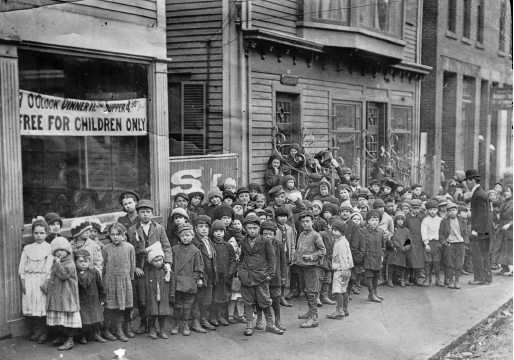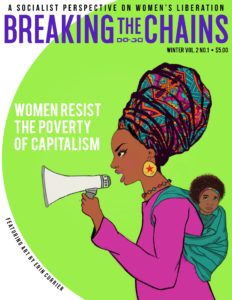
As we come marching, marching in the beauty of the day,
A million darkened kitchens, a thousand mill lofts gray,
Are touched with all the radiance that a sudden sun discloses,
For the people hear us singing: “Bread and roses! Bread and roses!”
— Bread and Roses by James Oppenheim
Oppenheim’s 1911 poem parallels the radiance of the sun with the voices of the workers who demand “Bread and Roses.” Like the workers in Oppenheim’s poem of the same name, the 1912 Lawrence Textile Strike or “Bread and Roses” strike, as it is sometimes called, became a lightning rod for workers amidst the darkness of intense exploitation. The strike was a fight for decent wages, dignity and equality. It was a historic strike as mostly immigrant, mostly women workers overcame numerous obstacles to wrest a significant victory from the manufacturing industry owners.
The strike, which lasted nine weeks, began on a wintry day in a textile mill in Lawrence, Massachusetts. But its roots grew in the inhumane conditions of the mill factories where workers, the majority immigrant women and children, labored for 60-plus hours a week in danger and squalor. Workers entered the mills not knowing whether they would make it out in one piece, as frequent accidents on the job killed and maimed many. Hours of mill work meant losing years off your life, as life expectancy for textile workers was far less than that of the population as a whole. Workers not killed in accidents were exposed to toxic fibers and dust that often led to death.
On top of all this, workers were paid a meager wage, placing mill workers in a never-ending cycle of poverty. They lived under abominable conditions characterized by unsanitary drinking water, overcrowded apartments and rampant food insecurity. Children were robbed of any semblance of a childhood, as many had to enter the workforce to help their families survive. Amidst the exploitation and oppression, the workers, mostly women, began to organize themselves.
On Jan. 11, 1912, Polish women at the Everett Cotton Mill walked off the job after learning that employer had cut wages to maneuver their way around the reduced work-hour law. On Jan. 12, workers at the Washington Mill learned the same and also walked out. By Jan. 15, 15,000 workers were on strike and out on the picket line. Eventually, 25,000 people joined the lines and shut down the mills.

The strike was sparked by a single event that induced an angry fervor, but it was not spontaneous. Its seed was planted in the kitchens and hallways of tenement buildings. The bosses believed that women as ethnically diverse as those working in the mills of Lawrence were too different to relate to each other. Yet, the women formed close social bonds as they looked after each other’s kids and tended to each other’s illnesses. These relationships would carry them through the nine weeks of strike.
Many women had been exposed to labor organizing in their home countries, setting the stage for alliances to be formed with worker unions such as the Italian Socialist Federation and the Industrial Workers of the World. These alliances allowed for the seeds of solidarity that were planted among them to grow into fruition.
Women became the true leaders of this strike. It was women who placed themselves at the front of the marches in an attempt to curtail the violence. It was women who led the way throughout the city of Lawrence as they marched. It was the women who injected their vitality, fight and passion into this strike as they sang songs that maintained the high revolutionary spirit.
Additionally, it was women who made decisions about how to best protect their families during the strike. The women sent their children to live with relatives in New York City and other cities, making sure they were well cared for while they engaged in necessary militant action and withstood the brutality of the state. The decision to send their children to nearby cities went beyond necessity—it was very much about strategy and about increasing the strikers’ visibility. This decision also garnered media attention when police brutally halted the practice on Feb. 24.
The bosses and the authorities, in collusion, initially dismissed the strikers, since they were unskilled immigrant workers. The workers’ effective organization and militancy proved the bosses wrong. Instead of diminishing, the strike’s power grew as time progressed.
The bosses and the state collaborated and violently attacked the strikers. There were mass beatings of women and children —mothers were savagely grabbed by their hair and dragged in front of their children. Yet, the workers remained steadfast. Day after day, they took their place on the picket line. They continued to chant for dignified wages and living conditions. On the picket lines, unity and optimism empowered the striking workers to overcome the bitter hunger, cold and police bullets.
The public’s eye settled on the women and children; their stories of exploitation in juxtaposition to their resistance swayed public opinion in their favor.
The strikers went from being a force to be reckoned with in Lawrence to being a threatening body to the capitalist forces in the region. The strike became the largest manufacturing strike at that time. After nine difficult weeks of striking, the workers won their demands. They received a 15-percent wage hike and an increase in overtime compensation.
The victory was not handed to them; it was hard-earned. The women, men and children who stood on the picket lines fought for the entire working class. They showed that only through unity in struggle can workers win important reforms.
As women, as workers, it is our duty to advance the cause for the revolution by actively fighting for it. Women workers are part of a long tradition of labor struggle that has fought for workers’ rights. We stand up for what we believe. We mobilize against the systems that oppress us. We strategize to find the most effective tactics in order to win. We must continue to be at the forefront of all struggles against poverty and for the economic liberation of all workers. The least we can do is stand on the shoulders of those giants from the Bread and Roses strike and continue their fight for the liberation of all workers.

